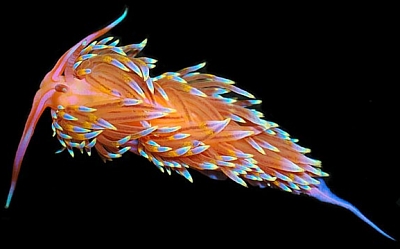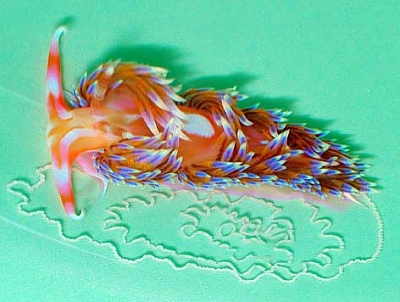Godiva quadricolor? from sthn Queensland
July 20, 2006
From: Gary Cobb


Concerning message #16643:
Hi Bill,
After reading the message on Godiva quadricolor I thought it important to send this message to you. I have drift dived in the Caloundra Pumisestone Passage and found Godiva quadricolor living very well. The animals are by far much more vibrant than any I have seen before.
Locality: Caloundra Pumicestone Passage, 3 m, Queensland, Pacific Ocean, 05 Oct 2004, Subtidal. Length: 58 mm. Photographer: Gary Cobb.
Richard Willan wrote a paper a while ago about the discovery of this species here on the east coast of Australia. I believe the animals are occuring there because the container ships actually turn the marker off the passage entry.
I think this is a new record for eastern Australia!
-
Willan, R.C. 2004. Godiva quadricolor (Barnard, 1927) (Nudibranchia: Facelinidae) spreads into southern Queensland. The Beagle, Records of the Museums and Art Galleries of the Northern Territory, 20: 31-36.
Cheers
Gary
gary@nudibranch.com.au
Cobb, G.C., 2006 (Jul 20) Godiva quadricolor? from sthn Queensland. [Message in] Sea Slug Forum. Australian Museum, Sydney. Available from http://www.seaslugforum.net/find/16770
Dear Gary,
Thanks for these photos. It raises the question of whether this is Godiva quadricolor or not. It is one of the reasons I have been encouraging contributors from Sth Africa to send us photos of their 'typical' animal. I am pretty sure your animal is Godiva rachelae, a species I initially described from specimens I collected in Tanzania and specimens collected at Broadhurst Reef, off Townsville, Queensland in August 1975. So whatever its name is, it is not a new arrival in Queensland.
Anatomically the two species are quite similar, but that is usual in these aeolids, but there are differences in radular morphology and colour. Now I have seen more photos of Sth African specimens it seems they have shorter cerata, and the ceratal clusters have more cerata than G. rachelae. Another problem is that G. quadricolor is part of Sth Africa's coldwater endemic fauna while G. rachelae seems to have a tropical Indo-West Pacific distribution. I guess you could say I am biased since I named the species, but I feel no 'ownership' over the name. I think we will have to wait until DNA testing can give us an unambiguous result, but my feeling, which is reinforced everytime I see another photo from Sth Africa, is that we are dealing with two species.
Best wishes,
Bill Rudman
Related messages
-
Godiva rachelae from Tanzania
From: Bill Rudman, February 15, 2002
